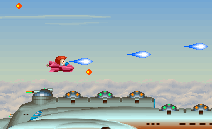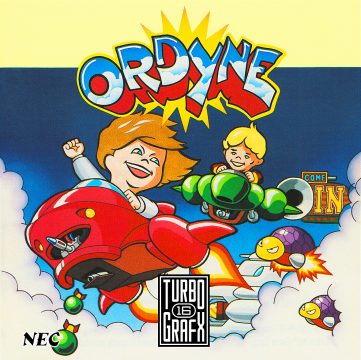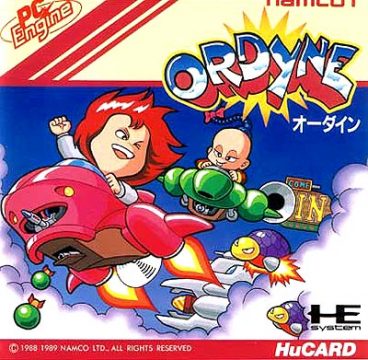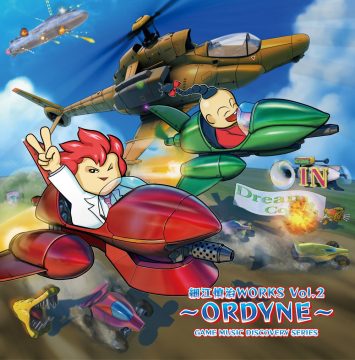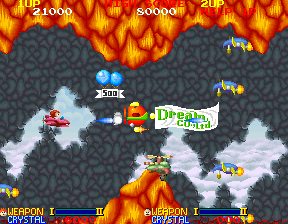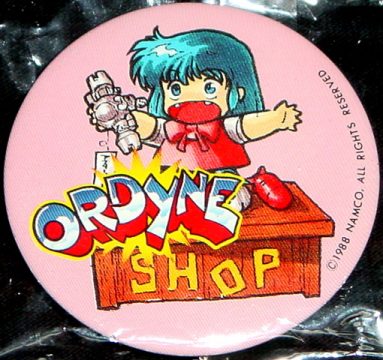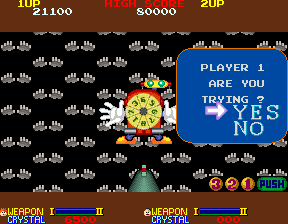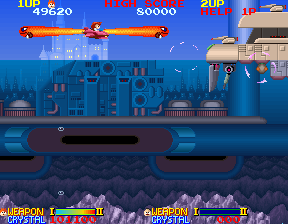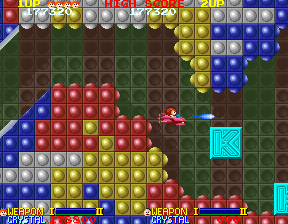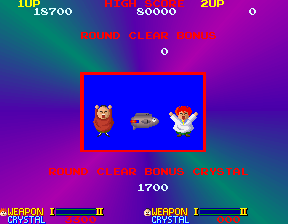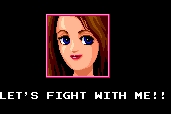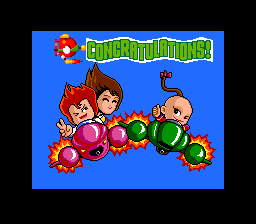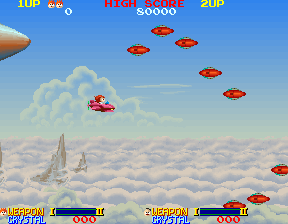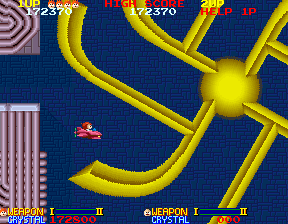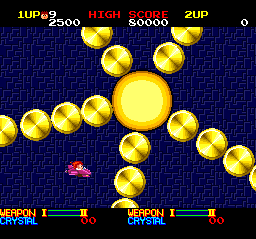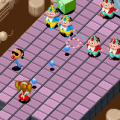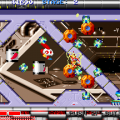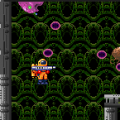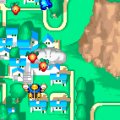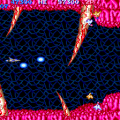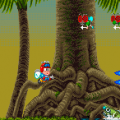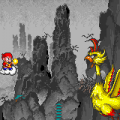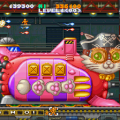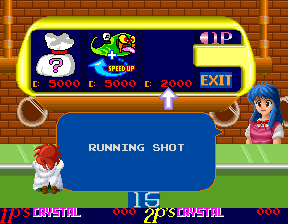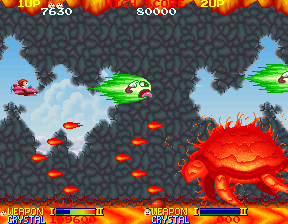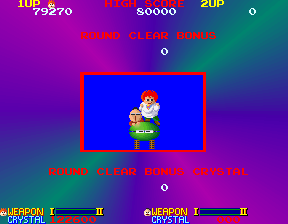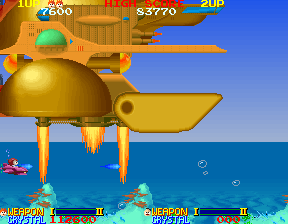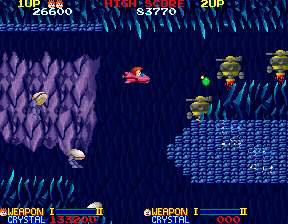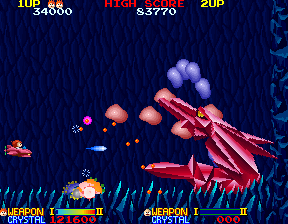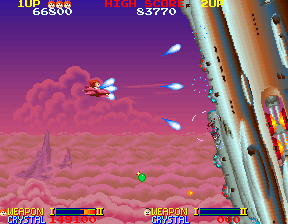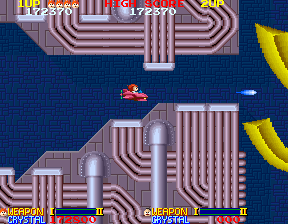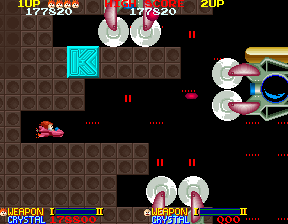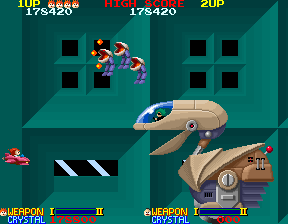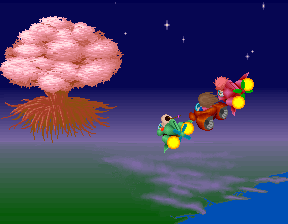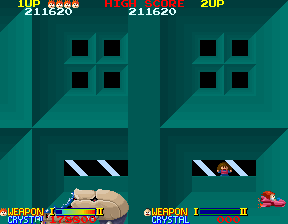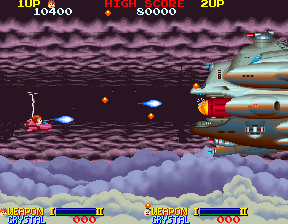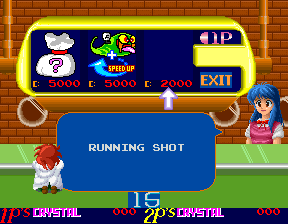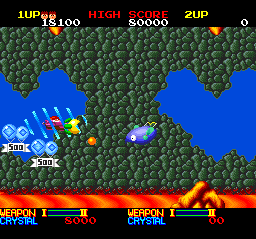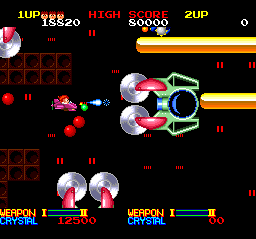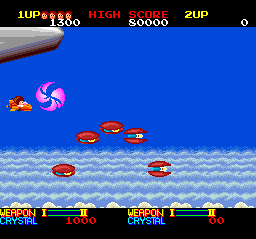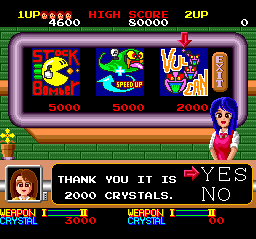Namco is known for a number of shooters – Xevious, Dragon Spirit, Phelios – which are mostly vertically-oriented. Ordyne is a break from these, a side-scrolling shooter with a light-hearted, vaguely goofy theme. The game stars professor Yuichiro Tomari and his assistant Sunday Chin, as they pilot a pair of open-cockpit ships and wage war against the evil Dr. Kubota, who’s kidnapped the doctor’s fiancée Kana.
Ordyne owes a very heavy debt to Gradius. The pacing, the enemy formations, and in some cases the enemies themselves. Even the control scheme, which splits the offensive weapons between regular forward-firing weapons and low-angle firing bombs is the same. Where it differentiates itself is the power-up system, which is more closely influenced by Fantasy Zone. Destroyed enemies drop crystals, which are used to purchase weapons at shops found throughout each stage. Each shop has a set stock of three power-ups to choose from.
In addition to speed-ups and extra lives, you can find upgrades for both the main weapon and the bomb/missiles, including three-way shots, Vulcan cannons, a dual-direction “after burner” shot, fire bombs, and homing missiles. The shield is called a Stock Bomber, and brings in Pac-Man for a cameo, who sits at the front of the ship and gobbles up enemy bullets.
Unfortunately, while each store has different items, they have the same stock each time, so the amount of customization is limited. Furthermore, you can only pick one item before you’re kicked out of the store. In the later areas, certain power-ups are bundled together, but in the beginning, it’s pretty annoying that you’re forced to choose between a speed-up or a not-crappy gun. Even then, all of the weapons are time limited, and since there are usually only two or three shops in a level, you spend most of the game somewhat underpowered.
Most levels also have a Dream Co. Ltd robot, where you can play a timing based minigame to get either more power-ups or extra money. If you’re really good (and lucky) you can win such a huge cash prize that you’ll be set up for cash for at least half the game.
Compared to Gradius, Ordyne isn’t too difficult, which is maybe why the arsenal is so limited, to prevent you from becoming too overpowered. You pick up immediately where you left off when you die, and only get sent back to a checkpoint when you continue. It’s not nearly as frustrating as Konami’s shooters, but the levels aren’t as tightly designed either, nor the boss encounters as harrowing.
Visually, the game is far brighter than most shoot-em-ups, but it’s really not cute enough to be considered a cute-em-up. The enemies designs aren’t funny so much as just bizarre, and it’s missing the chaotic gleefulness of a Parodius or the pastel creativity of TwinBee. Similarly, there’s nothing really wrong with the level designs, they just lack creativity. A few stages take place in the sky, one in the ocean, one in a lava cave. Near the end of the game, there’s a boss rush, which is typical of Gradius… but Konami’s series featured boss fights from previous games. Since Ordyne doesn’t have the same lineage, it just has you fight bosses from earlier in the game.
There are a few types where the game puts the arcade hardware’s sprite and background rotations to use, as enemy battleships occasionally tilt and fly upside down, or gigantic wheels turn slowly, requiring you to weave between the blocks attached it. Otherwise, the only truly creative stage is the last one, which starts off as a typical “fight through the interior of a gigantic enemy base” level, except in this one you dodge gigantic pistons and somewhere end up stumbling into a corridor built of Lego-ish blocks.
The soundtrack was composed by Shinji Hosoe, who also worked on the Dragon Spirit games. It’s a fairly catchy soundtrack, accentuated with goofy sampled effects, like the horn honking in the first level. Unfortunately, elsewhere the sound designers went overboard with the digitized effects, with some enemies accompanied with positively grating warbling noises.
Ordyne was ported to the Turbografx-16, a year or so after its arcade release. Namco published a number of titles on the platform, and many stayed in Japan, but this one was one of the few to see a North American release. What’s particularly amusing is that the front covers are almost identical, except Professor Tomari has different hair, and Sunday Chin has been changed into a blond kid. However, both characters remain unaltered in the game itself. The visuals are still bright and colorful, but the backgrounds are missing substantial amount of detail, and little things are absent, like the bugged-out look of your character after their ship is destroyed, as they hover in mid-air waiting for a replacement to zoom in. It’s also missing the post-level images of Tomari and Sunday beating up chibi-versions of the level bosses.
The status bars have black backgrounds, letterboxing the view slightly, and since the level designs weren’t changed, they scroll vertically a bit to compensate. The system couldn’t handle image rotation either, so these obstacles are simplified into blocks that move in rotational patterns, just without the spinning backgrounds. The music is scratchier, and it loses some of its pizzazz without the sound samples.
There’s also a cheat code to play as Kana, who was previously only seen in the game’s ending. However, rather than a new character sprite, it’s just a palette swap of Tomari, along with changed portraits in the shop screen. The ending has been slightly expanded, with a few more cinema stills of Kana’s rescue before they escape from the fortress.
Ordyne was also ported to the PlayStation, as part of the Namco Museum Vol. 4 collection, and is essentially a perfect translation of the arcade game. Both the PC Engine and arcade versions were listed on the Wii Virtual Console, but only in Japan.
Professor Tomari, Kana, and the shopkeeper girl all inspired names of characters on the Namco All Stars team in the Family Stadium and World Stadium EX baseball series. Sadly, Kana is just a generic pitcher in the game she appears in, Super World Stadium ’99, without her own unique character model, unlike some of Namco’s other heroines. The PlayStation version of the latter game features a vocal rendition of the Ordyne theme song. Additionally, a medley of Ordyne‘s music also appears in the Taiko Drum Master games.
Screenshot Comparisons
